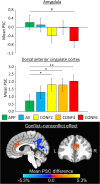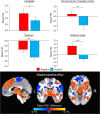Test-retest reliability of approach-avoidance conflict decision-making during functional magnetic resonance imaging in healthy adults
- PMID: 33650761
- PMCID: PMC8090786
- DOI: 10.1002/hbm.25371
Test-retest reliability of approach-avoidance conflict decision-making during functional magnetic resonance imaging in healthy adults
Abstract
Neural and behavioral mechanisms during approach-avoidance conflict decision-making are relevant across various psychiatric disorders, particularly anxiety disorders. Studies using approach-avoidance conflict paradigms in healthy adults have identified preliminary neural mechanisms, but findings must be replicated and demonstrated as reliable before further application. This study sought to replicate previous findings and examine test-retest reliability of behavioral (approach behavior, reaction time) and neural (regions of interest [ROIs]) responses during an approach-avoidance conflict task conducted during functional magnetic resonance imaging (fMRI). Thirty healthy adults completed an approach-avoidance conflict task during fMRI on two occasions (mean interval: 17 days; range: 11-32). Effects of task condition during three task phases (decision-making, affective outcome and monetary reward) and intraclass correlation coefficients (ICCs) were calculated across time points. Results replicated that approach behavior was modulated by conflict during decision-making. ROI activations were replicated such that dorsal anterior cingulate cortex (dACC) was modulated by conflict during decision-making, and dACC, striatum, and anterior insula were modulated by valence during affective outcomes (p's <.0083). Approach behavior during conflict demonstrated excellent reliability (ICCs ≥.77). Activation of dACC during conflict decision-making and anterior insula during negative outcomes demonstrated fair reliability (ICCs = .51 and .54), and dACC and striatum activation demonstrated good reliability during negative outcomes (ICCs = .63 and .69). Two additional ROIs (amygdala, left dorsolateral prefrontal cortex) showed good reliability during negative outcomes (ICCs ≥.60). These results characterize several specific behavioral and neuroimaging responses that are replicable and sufficiently reliable during approach-avoidance conflict decision-making to support future utility.
Keywords: ICC; affect; anxiety; fMRI; neural; psychiatry; translation.
© 2021 The Authors. Human Brain Mapping published by Wiley Periodicals LLC.
Conflict of interest statement
The authors have no conflict of interest to disclose.
Figures







Similar articles
-
Neural substrates of approach-avoidance conflict decision-making.Hum Brain Mapp. 2015 Feb;36(2):449-62. doi: 10.1002/hbm.22639. Epub 2014 Sep 15. Hum Brain Mapp. 2015. PMID: 25224633 Free PMC article.
-
Visual cortical regions show sufficient test-retest reliability while salience regions are unreliable during emotional face processing.Neuroimage. 2020 Oct 15;220:117077. doi: 10.1016/j.neuroimage.2020.117077. Epub 2020 Jun 20. Neuroimage. 2020. PMID: 32574806 Free PMC article.
-
Examining the Role of the Human Hippocampus in Approach-Avoidance Decision Making Using a Novel Conflict Paradigm and Multivariate Functional Magnetic Resonance Imaging.J Neurosci. 2015 Nov 11;35(45):15039-49. doi: 10.1523/JNEUROSCI.1915-15.2015. J Neurosci. 2015. PMID: 26558775 Free PMC article.
-
Animal to human translational paradigms relevant for approach avoidance conflict decision making.Behav Res Ther. 2017 Sep;96:14-29. doi: 10.1016/j.brat.2017.04.010. Epub 2017 Apr 24. Behav Res Ther. 2017. PMID: 28495358 Free PMC article. Review.
-
The differential neural substrates for reward choice under gain-loss contexts and risk in alcohol use disorder: Evidence from a voxel-based meta-analysis.Drug Alcohol Depend. 2023 Jul 1;248:109912. doi: 10.1016/j.drugalcdep.2023.109912. Epub 2023 May 4. Drug Alcohol Depend. 2023. PMID: 37182355 Review.
Cited by
-
Interindividual differences in Pavlovian influence on learning are consistent.R Soc Open Sci. 2023 Sep 20;10(9):230447. doi: 10.1098/rsos.230447. eCollection 2023 Sep. R Soc Open Sci. 2023. PMID: 37736528 Free PMC article.
-
Striatal reactivity during emotion and reward relates to approach-avoidance conflict behaviour and is altered in adults with anxiety or depression.J Psychiatry Neurosci. 2022 Sep 1;47(5):E311-E322. doi: 10.1503/jpn.220083. Print 2022 Sep-Oct. J Psychiatry Neurosci. 2022. PMID: 36223130 Free PMC article.
-
Approach-avoidance conflict recruits lateral frontoparietal and cinguloinsular networks in a predator-prey game setting.Cogn Affect Behav Neurosci. 2025 Aug;25(4):904-922. doi: 10.3758/s13415-025-01278-0. Epub 2025 Feb 26. Cogn Affect Behav Neurosci. 2025. PMID: 40011405
-
Why Stuttering Occurs: The Role of Cognitive Conflict and Control.Top Lang Disord. 2022 Jan-Mar;42(1):24-40. doi: 10.1097/tld.0000000000000275. Top Lang Disord. 2022. PMID: 40521301 Free PMC article.
-
Measuring maladaptive avoidance: from animal models to clinical anxiety.Neuropsychopharmacology. 2022 Apr;47(5):978-986. doi: 10.1038/s41386-021-01263-4. Epub 2022 Jan 15. Neuropsychopharmacology. 2022. PMID: 35034097 Free PMC article. Review.
References
-
- American Psychiatric Association . (2013). Diagnostic and statistical manual of mental disorders (5th ed.). Washington, DC: American Psychiatric Association.
Publication types
MeSH terms
Grants and funding
LinkOut - more resources
Full Text Sources
Other Literature Sources

